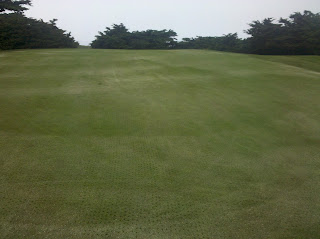This blog highlights some of my fun and interesting experiences along the way. - AG
Thursday
Wednesday
Adding an irrigation sprinkler head
Pink Snow Mold


The correct name for the disease many know as pink snow mold or Fusarium patch is now Microdochium patch. Over the years, the fungus which causes this disease (now called Microdochium nivale) has been reclassified and renamed many times. Pink snow mold is common and troublesome where prolonged periods of wet, cool weather occur during winter and spring. The disease often occurs in the absence of snow and is favored by cool or cold wet weather when grass growth is slow. Disease development occurs rapidly when humidity is high and temperatures are 32 to 46 F with a maximum of about 55 F. The disease first appears as round, water-soaked spots, 1 to 3 inches in diameter, that soon turn into yellow, orange-brown, or reddish brown patches. Patches may enlarge and become light gray or light tan rings. Under snow cover or with very wet conditions, varying amounts of white fungal growth may be seen on matted leaves. Where there is snow cover, the disease may blight large areas. As the snow melts, the white fungal growth at the perimeter of the patch turns pink; hence the name "pink snow mold".
Friday
Greens mower demo
Thursday
Soil Sampling
Today I took a number of soil samples on greens 5, 12 and 17. On these greens we are experimenting with a different fertilizer and the soil test will be able to prove if this fertilizer is doing a better job than what we currently use. To take the soil sample i used a 3/4 inch probe, took a sample of around 6 inches because that is where the roots are located. I then shook the soil off the core and placed the turf back in the hole and repaired to minimize damage.
Greens Aerification
Monday the 14th we aerified, topdressed, broomed and blew the sand into the holes. This is very important for the health of the greens. Aerification helps with water infiltration, getting oxygen to the roots and removing thatch. Topdressing helps smooth the putting surface and fill the holes to provide the best putting surface possible. Additional topdressing will be needed to touch up areas and fill in holes that were missed. The course was closed the entire day making this process extremely easy and helping us complete it all in one day.
Wednesday
Erosion Control
Friday
Fairy Ring
Throughout the golf course there is alot of fairy rings on the fairways. There are 3 types of fairy rings, Type 1 causes the soil to be hydrophobic, Type 2 causes the turf to grow quicker and is dark green in appearance, Type 3 causes mushrooms to appear and all are in arcs or circles. Fairy Rings occur from decaying organic matter from a number of sources such as old stumps or decaying tree roots. First we aerified the whole surface in 2 directions than applied a fungicide and wetting agent in a drench application
Monday
Bunkers
Last week we backpacked sprayed the bunker faces with round up to eliminate the fescue and weed intrusion. We spray the weeds because it is more efficient than having the crew spend countless hours hand pulling the weeds, another reason is to eliminate the risk of pulling the bunker liner up with the weeds. I was especially careful with this application because any product reaching the turf would cause yellowing and eventually death. I also had to be very careful not to get any on my boots because than anywhere I walked would leave a foot printing affect.


















